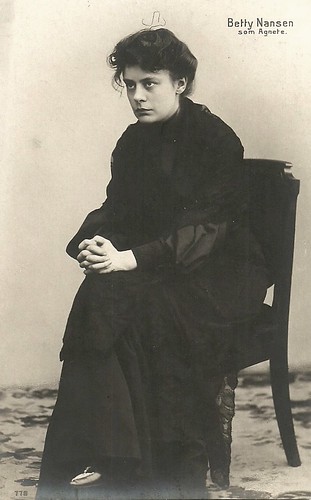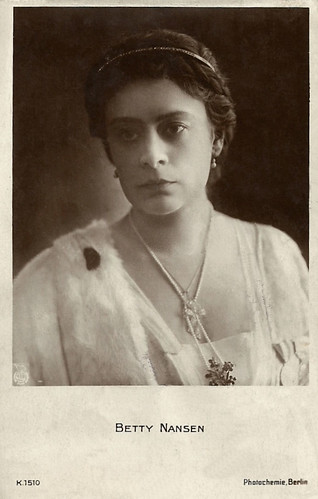
German postcard by Verlag Hermann Leiser, Berlin-Wilm., no. 7483.

German postcard by Photochemie, Berlin, no. K. 1470.
The primadonna of the Copenhagen theatre
Betty Nansen née Betty Anna Maria Müller in 1873 – was the daughter of actor, theatre manager, and stage director at the Dagmarteatret Frederik Carl Christian Oscar Müller and his wife, actress Maria Petrine Petersen.
In 1892 Nansen entered the theatre school of Det kongelige Teater (Royal Danish Theatre). In 1893 she debuted in Victorien Sardou’s 'Dora' at Copenhagen’s Casino Theater, after which she played Magda in the German play 'Hjemmet' (Heimat/Homeland) by Hermann Sudermann.
She soon became the primadonna of the Copenhagen theatre. Between 1896 and 1899 she was employed at The Royal Theatre, debuting as Martha Bernick in Henrik Ibsen’s 'Samfundets støtter' (Pillars of Society) and playing also Bødvild in 'Vølund Smed' (Wayland the Smith).
She then moved to the Dagmarteatret, where she had her real breakthrough between 1899 and 1903. She acted in all kinds of plays such as the Norwegian play 'Paul Lange og Tora Parsberg'. She had individual guest performances at the Nationaltheatret i (National Theatre) in Norway in June 1902, October 1903, and May 1910.
Furthermore, she visited her Nationaltheatret in Spring 1903 as the head of a Danish tour, and again in August-September 1926, she visited Den Nationale Scene in Norway, this time with her second husband Henrik Bentzon. Nansen left the Dagmar Theatre in 1903 when she couldn’t stand Martinius Nielsen's despotic leadership anymore.
She went to the People's Theatre, where she became the first female Copenhagen theatre manager and joined this as co-director as well until 1905. Here she played the title role in 'Agnes' which was one of her greatest successes in her early career. In the years 1907-1910, she was again an actress at the Royal Theatre. She visited the Norwegian and Swedish scenes and then returned to the Dagmarteatret until 1911.

Danish postcard by Ed. Paul Heckscher, no. 774. Photo: Mary Steen. Betty Nansen in the play 'Agnete'. In 1903 joined the People's Theatre, where she became the first female Copenhagen theatre manager and joined this as co-director as well until 1905. Here she played the title role in 'Agnete' (Agnes), which was one of her greatest successes in her early career.

Danish postcard by Ed. Paul Heckscher, no. 778. Photo: Mary Steen. Betty Nansen in the play 'Agnete'.
Acting in a few Hollywood films for Fox
In 1913 Betty Nansen debuted in film in the Nordisk production Bristet lykke/A Paradise Lost (August Blom, 1913), with Olaf Fönss and Poul Reumert. Nansen plays the wife of a rich attorney (Fönss), who is deluded her husband doesn’t care about her anymore, only about his work. She starts an affair with a baron, who proves to be a dangerous robber.
More films at Nordisk followed, mostly directed by the prolific August Blom, some by Holger-Madsen or Robert Dinesen. These included Prinsesse Elena/Princess Helena (Holger-Madsen, 1913) with Sven Aggerholm, Af elskovs nåde/Acquitted (August Blom, 1913) with Adam Poulsen, Moderen/The Mother (Robert Dinesen, 1913) with Nicolai Johannsen, and Hammerslaget (Robert Dinesen, 1913) with Johannsen and Aggerholm.
In 1914 followed Sønnen/Her Son (Agust Blom, 1914) with Carl Lauritzen and Arne Weel, Revolutionsbryllup/A Revolution Marriage (August Blom, 1914) with Valdemar Psilander and Nicolai Johannsen, Eventyrersken/Exiled (August Blom, 1914) with Aage Hertel, Under skæbnens hjul (Holger-Madsen, 1914), and finally En ensome kvinde/The Doctor’s Legacy (August Blom, 1914) with Frederik Jacobsen, which was only released in 1917.
In 1914 Nansen went to the United States where she tried to forge a career and acted in a few films for Fox, including starring roles in The Celebrated Scandal (released 1915), Anna Karenina (1915), A Woman's Resurrection (1915), and The Song of Hate (1915).
While Should a Mother Tell, based on a story and script by Rex Ingram, dealt with a mother who must choose between the happiness of her 16-year old daughter and innocent man, The Song of Hate was simply an adaptation by Ingram of Sardou’s play 'Tosca' (made even more famous by Puccini’s opera), with Nansen as Floria Tosca and Arthur Hoops as Scarpia. All these films were directed by J. Gordon Edwards. The films were, however, no success.

Danish postcard by Alex Vincents Kunstförlag, Eneret, no. 559. Betty Nansen in the Henrik Ibsen play 'Rosmersholm' (1906).

German postcard by Photochemie, Berlin, no. K. 1510. Photo: Nordisk Films.
Realising her dream of a new artistic scene in Frederiksberg
During these years, Betty Nansen did guest performances in both the Scandinavian capitals, but also in Russia, America, and France. In Paris, she played with Henrik Bentzon in 'Ghosts'.
In 1917 she bought the Alexandra Theatre at the Frederiksberg Allee and renamed it the Betty Nansen Theatre, creating one of the most literary theatres in the country. She sat at the helm and went as a talented stage director and administrator in the process of realising her dream of a new artistic scene in Frederiksberg.
The audience got the return of the prima donna already in the opening performance, a French comedy where Mrs. Director Nansen appeared as an exuberant young widow in a silver dress. Nansen remained head of the theatre until her death in 1943.
In 1936 something non-traditional happened when Stig Lommer had her perform in a show to the tune of Alexander's Ragtime Band. Betty Nansen surprised also with plans to expand the theatre, which henceforth would operate with a film company.
In her final years, Betty Nansen had plans for a film project, which she called the "Eternity film" - a modern film about the life of Jesus, where Henrik Bentzon was to play Christ and Nansen herself the Virgin Mary.
Betty Nansen was married in 1896 in Copenhagen with author and Gyldendal director Peter Nansen. The marriage lasted until 1912. In 1927, she was married to the 22 years younger Norwegian actor Henrik Bentzon. The marriage was dissolved in 1933.
Betty Nansen mingled often in the theatre politics debate. In the years 1935-1940, she was Chair of the Private Theaters Director Association. In 1907 Betty Nansen was awarded the medal Ingenio et Arti and in 1938 with the Order of Merit in gold. Along with Henrik Bentzon, she bought Kontumatshuset, the old Quarantine Station in Skagen, which they called "Strandgården". Betty Nansen died in 1943 and was buried in the dunes at Kontumatshuset.

British postcard by the Vandyck Printers, Bristol, and London. Photo: The Ideal Film Renting Co., London.

British postcard by the Vandyck Printers, Bristol, and London. Photo: The Ideal Film Renting Co., London.
Sources: Wikipedia (English and Danish), Danskefilm, and IMDb.
No comments:
Post a Comment